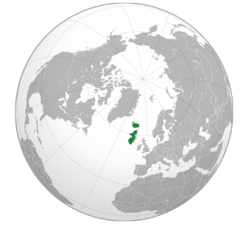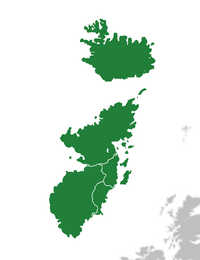Nelborne
This article is incomplete because it is pending further input from participants, or it is a work-in-progress by one author. Please comment on this article's talk page to share your input, comments and questions. Note: To contribute to this article, you may need to seek help from the author(s) of this page. |
 Orthographic projection of the Nelborne  | |
| Population | 22 million |
|---|---|
| Demonym | Nelborne Nelbornian (rarely used) |
| Countries | |
| Languages | |
| Time zones | WET (UTC+0) |
The Nelborne is a region and archipelago located in northwestern Europe. Situated on the Atlantic Ocean, the islands have a combined area of ~425,00 km2, with a population of approximately 22 million. The region contains the three Nelbec countries of Alquiya, Lormotia, and Seketan, along with Iceland, New Svealand, and the Kingdom of Trjebia.
Human settlement of the Nelborne occurred during the last glacial period where homo sapiens migrated from Europe. The Classical era of the Nelborne encompassed North Nelbec, South Nelbec, and Sjezon polities centred on the Treb Bay. By the 3rd century AD, the Nelborne entered into dark ages. The Christianization of the Nelborne in the 9th century was soon followed by viking invasions which saw the Norse settlement of New Svealand and Iceland. The early modern era saw the kingdoms of Alquiya and Seketan become fierce rivals over hegemon regional power, with further division occurring during the Nelborne Reformation.
After an Alquiyan-led personal union with Seketan endured for almost a century, the Nelbec Empire was established in 1884, later occupying Danish territories and invading an independent Lormotia and New Svealand during World War I before ultimately collapsing in 1919. Disputes regarding the boundary of Trjebia and between New Svealand and the Lormot Republic led to the Nelborne War, which ended in 1942 inconclusively. After the Nelborne Spring where Alquiya and Seketan began their transition to democracies, the 1981 Alquiyan-Seketese crisis was resolved by the Treaty of Joghen which began the development of Nelborne integration. The Nelbec Council and Nelborne Union were established in 1982 and 2004 respectively.
The Nelborne represents an integral part of European culture. Its socio-cultural characteristics are influenced by Nelbec, Nordic, and Sjezonic cultures, the development of Western Christianity, and the region's relative isolation from the rest of Europe. The contemporary people of the Nelborne are primarily of North Nelbec, South Nelbec, North Germanic, and Trjebian origin. Seketese is the most commonly spoken native language; English and French are the most common second languages.
The Nelborne Union is the most prominent international organization aiming to represent the Nelborne region on a political level. The Nelbec Council aims to promote cooperation within the Nelbec countries. Every sovereign state in the Nelborne is a member of the Council of Europe. The historical isolation of the Nelborne continues to factor in the politics of Nelborne states regarding European integration.
Name
Etymology
Historical names
Definition and boundaries
In its most inclusive definition, the Nelborne includes the islands of Nelbecia, Iceland and surrounding smaller islands. The inclusion of Iceland is occasionally omitted in many political contexts regarding the island country's stronger connection with mainland Europe.
The Nelborne as a strictly geographical term is predominantly considered to be within northern Europe, sometimes northwestern Europe but seldom western Europe. The countries of the Nelborne are generally considered to be part of the Western world, although this identity is weaker in the Nelbec countries.
History
Classical period
Middle ages
Early modern
Modern
Geography
The Nelborne is situated in the Atlantic Ocean between the North Sea and the Nelborne Sea in northwestern Europe. The region contains two main islands, Nelbecia and Iceland, as well as thousands of surrounding smaller islands. Most of Nelbecia is highly mountainous with sprawling ravine systems and taiga, with the central Trjebian plains, the Fjeskan plains to the northeast, and tundra forming to the north.
The principal landmasses of the Nelborne split from Pangaea 237 million years ago, eventually forming the two islands of Nelbecia and Iceland. The Fjoške and Yerjtan mountain ranges strike through the north-south axis of the Nelborne, with the entire region holding extensive volcanic activity.
View of Conelibek, Seketan from Lake Seketan.
View of the Fjeskan plains in Falanda, New Svealand.
View of King Vjade II square in Vlyade, Lormotia
View of the Green line in suburban Avro, Alquiya
Politics
Of the six sovereign states within the Nelborne, 3 are constitutional republics and 3 are constitutional monarchies.
Regional organizations
The Nelbec Council and the Nelborne Union are the two pruinciple international organizations that function in the Nelborne.
EU and EEA membership
No state in the Nelborne is a European Union memberstate, and only Iceland is a member of the European Economic Area. Euroscepticism is predominant, although European integration is more popular in the Nordic Nelborne countries.
List of sovereign states
| Arms | Flag | Name | Population |
Capital | Name(s) in prominent language(s) | Official Languages |
|---|---|---|---|---|---|---|

|
Republic of Alquiya | 6,562,284 | Vilderjen | Selcijen (Alquiyan) Šeriğa (Southern Trjebian) |
Alquiyan, Trjebian | |
| Iceland | 350,710 | Reykjavík | Ísland (Icelandic) | Icelandic | ||

|

|
Kingdom of Lormotia | 3,562,553 | Vlyadel | Lormoyt (Lormotian) Lormojt (Seketese) |
Lormotian |

|

|
Kingdom of New Svealand | 4,452,357 | Rosenburg | Ny Svealand (Svealandic) Nou Seilat (Fjeskan) |
Svealandic |

|

|
Republic of Seketan | 6,426,108 | Conelibek | Sécytan (Seketese) | Seketese |

|

|
Kingdom of Trjebia | 423,886 | Dremem | Dhredhri (North Trjebian) Tretrei (South Trjebian) |
Trjebian |
Demographics
Languages
The Nelborne has dozens of indigenous languages, entirely within the Indo-European branches of Germanic, Nelbec, and Sjezonic.







